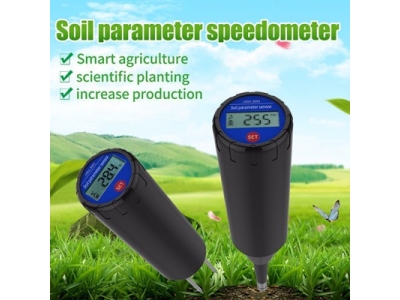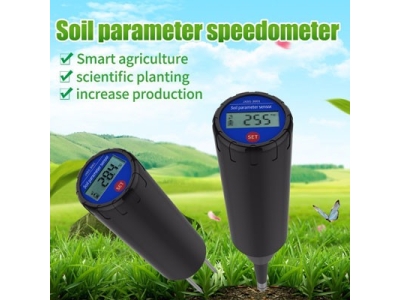Soil moisture is a critical parameter that plays a key role in the functioning of terrestrial ecosystems and agricultural systems. The availability of water in the soil affects plant growth, crop productivity, nutrient cycling, and overall ecosystem health. Monitoring soil moisture levels is essential for efficient water management, sustainable agriculture, and environmental conservation. In recent years, the development and deployment of soil moisture sensors have revolutionized the way we monitor and manage soil moisture in various land types, from agricultural fields to natural ecosystems. This article explores the role of soil moisture sensors in land monitoring and their implications for sustainable land management practices.

Understanding Soil Moisture
Soil moisture refers to the amount of water present in the soil, typically expressed as a percentage of the soil's total volume. Soil moisture plays a crucial role in plant growth and development, as it influences the availability of water and nutrients for plants. Soil moisture levels can vary significantly depending on factors such as soil type, vegetation cover, climate, and land use practices. Monitoring soil moisture levels is essential for optimizing irrigation schedules, preventing water stress in crops, and conserving water resources in agricultural and natural ecosystems.
Traditional methods of measuring soil moisture, such as soil sampling and gravimetric analysis, are labor-intensive, time-consuming, and provide only a spatially limited snapshot of soil moisture conditions. In contrast, soil moisture sensors offer a practical and efficient solution for continuous monitoring of soil moisture levels in real time. Soil moisture sensors are devices that can be installed in the soil to measure and record soil moisture data at regular intervals, providing insights into soil moisture dynamics, plant water uptake, and water availability in the root zone.
Types of Soil Moisture Sensors
There are various types of soil moisture sensors available on the market, each utilizing different principles and technologies to measure soil moisture accurately. Some common types of soil moisture sensors include:
1. Tensiometers: Tensiometers measure soil water tension, which is a direct indicator of soil moisture availability to plants. Tensiometers consist of a porous ceramic cup filled with water and a pressure gauge that measures the suction pressure in the soil. By measuring the tension in the soil, tensiometers can provide information about the energy required for plants to extract water from the soil.
2. Time Domain Reflectometry (TDR) sensors: TDR sensors measure soil moisture by sending electromagnetic pulses into the soil and measuring the reflection time of the pulses. The dielectric properties of the soil influence the speed of the pulses, which can be correlated with soil moisture content. TDR sensors are commonly used for precise measurements of soil moisture in different soil types and depths.
3. Capacitance sensors: Capacitance sensors measure soil moisture by detecting changes in the dielectric permittivity of the soil. These sensors use electrodes to measure the capacitance of the soil, which is proportional to the soil moisture content. Capacitance sensors are versatile and can be used in a wide range of soil types and conditions.
4. Neutron probes: Neutron probes measure soil moisture by detecting the interaction between fast neutrons and hydrogen atoms in the soil. By measuring the intensity of scattered neutrons, neutron probes can provide accurate measurements of soil moisture content in the root zone. Neutron probes are highly precise but require specialized training for operation.
Benefits of Soil Moisture Sensors in Land Monitoring
The deployment of soil moisture sensors offers numerous benefits for land monitoring, agriculture, and environmental management. Some key advantages of using soil moisture sensors include:
1. Improved precision and accuracy: Soil moisture sensors provide precise and accurate measurements of soil moisture levels in real time, allowing for targeted irrigation, optimal nutrient management, and efficient water use in agricultural fields and natural ecosystems.
2. Increased productivity and crop yield: By monitoring soil moisture levels with precision, farmers and land managers can optimize irrigation schedules, prevent water stress in crops, and maximize crop yield through better water management practices.
3. Water conservation and sustainability: Soil moisture sensors help to prevent over-irrigation and water wastage by enabling farmers to apply water only when and where it is needed. By conserving water resources and promoting sustainable farming practices, soil moisture sensors contribute to environmental conservation and resilience to climate change.
4. Early detection of drought and water stress: Soil moisture sensors can detect early signs of drought and water stress in crops, allowing farmers to implement timely water-saving measures, such as adjusting irrigation schedules, mulching, or adopting drought-resistant crop varieties.
5. Data-driven decision-making: Soil moisture sensors generate real-time data on soil moisture conditions, which can be integrated with weather forecasts, crop models, and irrigation systems to make informed decisions about water management, crop production, and land use planning.
6. Cost-effective and efficient monitoring: Soil moisture sensors offer a cost-effective and efficient solution for continuous monitoring of soil moisture levels, reducing the need for manual sampling and laboratory analysis. By automating soil moisture monitoring, farmers and land managers can save time, labor, and resources.
Applications of Soil Moisture Sensors
Soil moisture sensors have a wide range of applications in land monitoring, agriculture, forestry, and environmental research. Some common applications of soil moisture sensors include:
1. Precision agriculture: Soil moisture sensors are used in precision agriculture to optimize irrigation, fertilization, and crop management practices based on real-time soil moisture data. By mapping soil moisture variability within fields, farmers can implement site-specific management strategies to improve crop productivity and resource use efficiency.
2. Forest management: Soil moisture sensors are employed in forest ecosystems to monitor soil moisture levels in forest soils, assess the impact of land management practices on water availability, and support forest restoration efforts. By monitoring soil moisture dynamics, foresters can make informed decisions about tree planting, thinning, and wildfire risk assessment.
3. Ecological research: Soil moisture sensors are valuable tools for studying ecosystem dynamics, hydrological processes, and plant-soil interactions in natural ecosystems. By monitoring soil moisture variations in different habitats, researchers can investigate the response of plant communities to environmental changes, such as drought, flooding, or land use conversion.
4. Land rehabilitation and restoration: Soil moisture sensors play a crucial role in and rehabilitation projects aimed at restoring degraded lands, improving soil fertility, and enhancing ecosystem resilience. By monitoring soil moisture levels in degraded soils, land managers can implement appropriate revegetation techniques, erosion control measures, and soil conservation practices to promote land recovery.
Future Directions and Challenges
As soil moisture sensors continue to evolve and become more sophisticated, there are several opportunities and challenges that lie ahead in the field of land monitoring and water management. Some future directions for the development and application of soil moisture sensors include:
1. Integration with remote sensing technologies: Combining soil moisture sensor data with satellite remote sensing data can provide a more comprehensive understanding of soil moisture dynamics at regional and global scales. Integrated monitoring systems that incorporate ground-based soil moisture sensors and satellite observations can improve the accuracy and spatial coverage of soil moisture information.
2. Adoption of wireless sensor networks: Wireless sensor networks offer the potential for real-time monitoring of soil moisture across large areas, enabling better spatial coverage and data sharing among stakeholders. By networking soil moisture sensors in agricultural landscapes, watersheds, and natural reserves, it is possible to create a holistic approach to land monitoring and water management.
3. Sensor calibration and validation: Ensuring the accuracy and reliability of soil moisture sensor measurements remains a challenge due to variations in soil properties, sensor placement, and environmental conditions. Calibration and validation procedures are essential for maintaining the precision and consistency of soil moisture sensor data and improving the quality of information for decision-making.
4. User-friendly data visualization and interpretation: Developing user-friendly interfaces and data visualization tools for soil moisture sensor data can enhance the accessibility and usability of information for farmers, land managers, and policymakers. By presenting soil moisture data in intuitive formats, such as maps, graphs, and alerts, users can make informed decisions about water management and land use practices.
Conclusion
In conclusion, soil moisture sensors play a crucial role in land monitoring by providing continuous and accurate data on soil moisture levels in agricultural fields, natural ecosystems, and urban landscapes. The deployment of soil moisture sensors enables precision agriculture, water conservation, sustainable land management, and informed decision-making for farmers, land managers, and environmental scientists. As we strive to address the challenges of climate change, food security, and water scarcity, the integration of soil moisture sensors into land monitoring systems will be essential for promoting resilient and sustainable land use practices and ensuring the long-term health of ecosystems and water resources.






